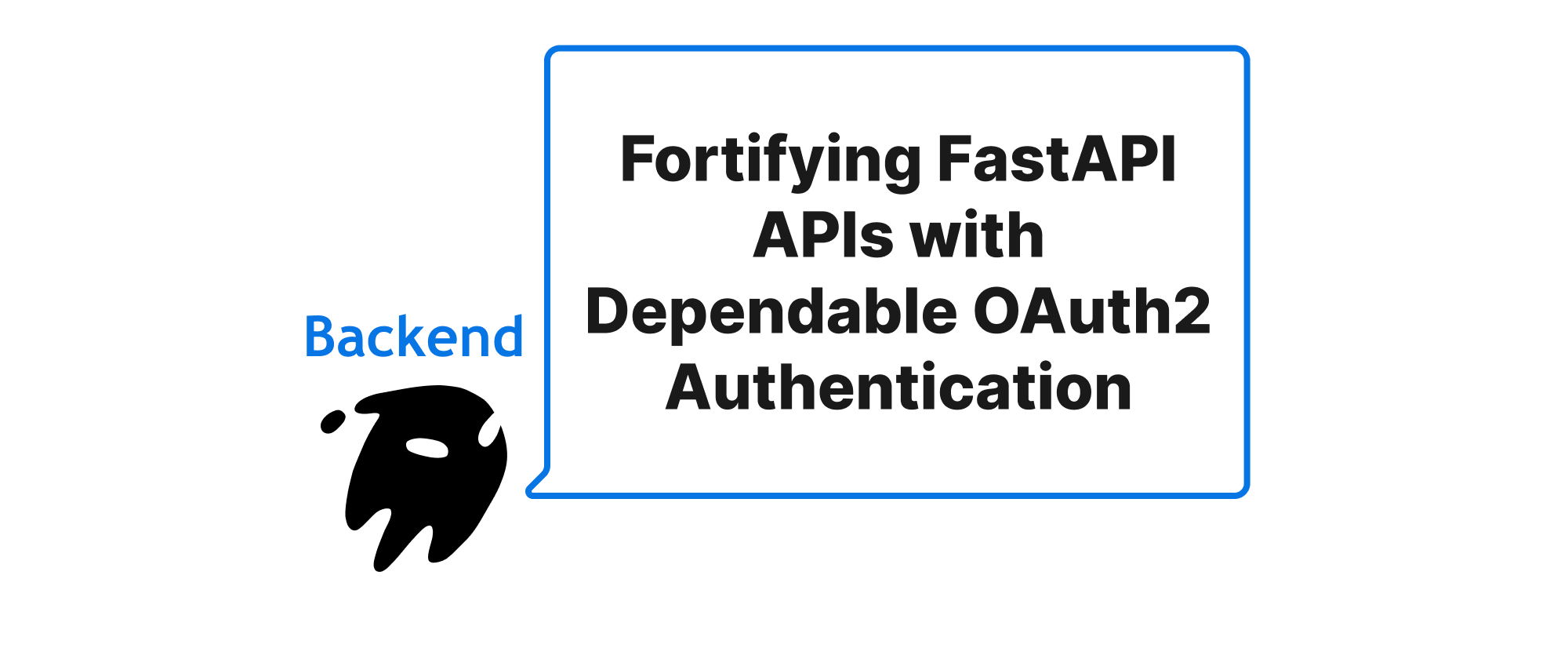Fortifying FastAPI APIs with Dependable OAuth2 Authentication
Emily Parker
Product Engineer · Leapcell

Introduction
In the ever-evolving landscape of web development, building secure and reliable APIs is paramount. As developers, we constantly strive to protect our endpoints from unauthorized access, ensuring that only legitimate users can interact with our applications. This challenge becomes particularly crucial for backend services that handle sensitive data or control critical operations. FastAPI, a modern, fast, and high-performance web framework for building APIs with Python 3.7+, offers elegant solutions for implementing robust authentication mechanisms. One such powerful combination involves leveraging FastAPI's dependency injection system (FastAPI Depends) alongside the industry-standard OAuth2PasswordBearer for token-based authentication. This article will delve into how these two features work in tandem to create secure and maintainable API authentication, transforming abstract security concepts into practical, actionable code.
Decoding Secure API Authentication
Before diving into the implementation details, let's establish a foundational understanding of the core concepts at play.
- OAuth2: OAuth 2.0 is an authorization framework that enables an application to obtain limited access to a user's protected resources on an HTTP service, such as Google, Facebook, or GitHub. The "Password Grant" in OAuth2, often combined with "Bearer Tokens," is a common method for initial user authentication in APIs.
- Bearer Token: A Bearer Token is a security token that is issued by an authorization server. The token grants the bearer (whoever possesses the token) access to protected resources. The token itself is simply an opaque string, and it should be transmitted over HTTPS to prevent eavesdropping.
- FastAPI Depends (Dependency Injection): FastAPI's dependency injection system allows developers to declare "dependencies" – functions or classes that an endpoint or another dependency requires. FastAPI automatically handles resolving these dependencies, making code reusable, testable, and modular. This mechanism is crucial for authentication, as it allows us to inject the current authenticated user or their credentials into our endpoint functions.
- OAuth2PasswordBearer: This class, provided by FastAPI's
fastapi.securitymodule, handles the extraction of a Bearer Token from theAuthorizationheader of an incoming request. It's designed specifically for OAuth2 Password Flow. If no token is found, or if the token is invalid (e.g., malformed header), it automatically raises anHTTPExceptionwith a401 Unauthorizedstatus.
The principle behind using OAuth2PasswordBearer with FastAPI Depends for authentication is straightforward: when a client makes a request to a protected endpoint, they send a Bearer Token in the Authorization header. OAuth2PasswordBearer intercepts this token, and a subsequent dependency (or the endpoint itself) validates the token. If valid, the authenticated user's information is passed down the dependency chain; otherwise, the request is rejected.
Implementation Walkthrough
Let's illustrate this with a practical example. We'll set up a simple FastAPI application with two endpoints: one for user login (which issues a JWT token) and another protected endpoint that requires authentication.
First, we need to install the necessary libraries:
pip install "fastapi[all]" python-jose[cryptography] passlib[bcrypt]
Here's the code:
from fastapi import FastAPI, Depends, HTTPException, status from fastapi.security import OAuth2PasswordBearer, OAuth2PasswordRequestForm from jose import JWTError, jwt from passlib.context import CryptContext from typing import Optional from datetime import datetime, timedelta # --- Configuration --- SECRET_KEY = "your-secret-key" # In a real app, use environment variables! ALGORITHM = "HS256" ACCESS_TOKEN_EXPIRE_MINUTES = 30 # --- FastAPI App Instance --- app = FastAPI() # --- Password Hashing Context --- pwd_context = CryptContext(schemes=["bcrypt"], deprecated="auto") # --- OAuth2PasswordBearer Instance --- oauth2_scheme = OAuth2PasswordBearer(tokenUrl="token") # "token" is the endpoint that issues the token # --- User Model (for simplicity, we'll use a dict) --- class UserInDB: def __init__(self, username: str, hashed_password: str, full_name: Optional[str] = None): self.username = username self.hashed_password = hashed_password self.full_name = full_name # Fictional user database fake_users_db = { "john.doe": UserInDB( username="john.doe", hashed_password=pwd_context.hash("securepassword"), full_name="John Doe" ), "jane.smith": UserInDB( username="jane.smith", hashed_password=pwd_context.hash("anothersecurepass"), full_name="Jane Smith" ) } # --- Helper Functions for Authentication --- def verify_password(plain_password: str, hashed_password: str) -> bool: return pwd_context.verify(plain_password, hashed_password) def get_user(username: str) -> Optional[UserInDB]: return fake_users_db.get(username) def authenticate_user(username: str, password: str) -> Optional[UserInDB]: user = get_user(username) if not user: return None if not verify_password(password, user.hashed_password): return None return user def create_access_token(data: dict, expires_delta: Optional[timedelta] = None): to_encode = data.copy() if expires_delta: expire = datetime.utcnow() + expires_delta else: expire = datetime.utcnow() + timedelta(minutes=15) to_encode.update({"exp": expire}) encoded_jwt = jwt.encode(to_encode, SECRET_KEY, algorithm=ALGORITHM) return encoded_jwt # --- Dependencies --- async def get_current_user(token: str = Depends(oauth2_scheme)) -> UserInDB: credentials_exception = HTTPException( status_code=status.HTTP_401_UNAUTHORIZED, detail="Could not validate credentials", headers={"WWW-Authenticate": "Bearer"}, ) try: payload = jwt.decode(token, SECRET_KEY, algorithms=[ALGORITHM]) username: str = payload.get("sub") if username is None: raise credentials_exception except JWTError: raise credentials_exception user = get_user(username) if user is None: raise credentials_exception return user async def get_current_active_user(current_user: UserInDB = Depends(get_current_user)): # You could add logic here to check if the user is active, enabled, etc. return current_user # --- API Endpoints --- @app.post("/token") async def login_for_access_token(form_data: OAuth2PasswordRequestForm = Depends()): user = authenticate_user(form_data.username, form_data.password) if not user: raise HTTPException( status_code=status.HTTP_401_UNAUTHORIZED, detail="Incorrect username or password", headers={"WWW-Authenticate": "Bearer"}, ) access_token_expires = timedelta(minutes=ACCESS_TOKEN_EXPIRE_MINUTES) access_token = create_access_token( data={"sub": user.username}, expires_delta=access_token_expires ) return {"access_token": access_token, "token_type": "bearer"} @app.get("/users/me") async def read_users_me(current_user: UserInDB = Depends(get_current_active_user)): return {"username": current_user.username, "full_name": current_user.full_name} @app.get("/items/{item_id}") async def read_item(item_id: int, current_user: UserInDB = Depends(get_current_active_user)): return {"item_id": item_id, "owner": current_user.username}
Detailed Explanation of the Code:
-
Configuration and Setup:
SECRET_KEY,ALGORITHM,ACCESS_TOKEN_EXPIRE_MINUTES: Essential for JWT creation and validation. Never hardcodeSECRET_KEYin production; use environment variables.pwd_context: An instance ofCryptContextfrompasslibfor secure password hashing.oauth2_scheme = OAuth2PasswordBearer(tokenUrl="token"): This is the heart of our OAuth2 integration. It tells FastAPI where the client can obtain a token (the/tokenendpoint) and handles parsing theAuthorization: Bearer <token>header.
-
UserInDBandfake_users_db:- A simple
UserInDBclass represents our user model. fake_users_dbacts as our in-memory user store for demonstration. In a real application, this would be a database connection.
- A simple
-
Authentication Helper Functions:
verify_password,get_user,authenticate_user: Standard helper functions for user lookup and password verification.create_access_token: This function generates a JSON Web Token (JWT) usingpython-jose. Thesub(subject) claim typically holds the user's identifier (username in this case). An expiration time (exp) is crucial for token security.
-
get_current_userDependency:async def get_current_user(token: str = Depends(oauth2_scheme)): This is a crucial dependency function.token: str = Depends(oauth2_scheme): Here,oauth2_scheme(an instance ofOAuth2PasswordBearer) is used as a dependency. When FastAPI encounters this, it will automatically try to extract the Bearer token from theAuthorizationheader. If successful, the token string is passed totoken; otherwise, a401 Unauthorizedexception is raised.- Inside the function, the token is decoded and validated using
jwt.decode. If the token is invalid (e.g., wrong secret, expired, malformed), aJWTErroris caught, and anHTTPExceptionis raised. - The username (from the
subclaim) is then used to retrieve theUserInDBobject. If the user doesn't exist, anotherHTTPExceptionis raised. - Finally, the authenticated
UserInDBobject is returned.
-
get_current_active_userDependency:- This is an optional, chained dependency. It takes the
UserInDBobject obtained fromget_current_userand could perform additional checks (e.g., if the user account is active, not banned, etc.). This demonstrates how dependencies can be chained for more complex validation.
- This is an optional, chained dependency. It takes the
-
/tokenEndpoint:@app.post("/token"): This endpoint handles user login.form_data: OAuth2PasswordRequestForm = Depends():OAuth2PasswordRequestFormis another FastAPI utility that parsesusernameandpasswordfrom form data, which is standard for the OAuth2 password grant type.authenticate_useris called to verify credentials. If successful, an access token is created and returned to the client.
-
Protected Endpoints (
/users/me,/items/{item_id}):current_user: UserInDB = Depends(get_current_active_user): This is where the magic happens. By declaringget_current_active_useras a dependency, FastAPI ensures that this function runs before the endpoint logic. Ifget_current_active_usersuccessfully returns aUserInDBobject, that object is then injected ascurrent_userinto the endpoint function, allowing us to access authenticated user data. If authentication fails at any point in theget_current_active_user(orget_current_user) dependency chain, the request is stopped, and a401 Unauthorizedresponse is sent.
Application Scenarios
This secure authentication pattern is suitable for a wide range of backend APIs:
- RESTful APIs: The most common use case, protecting endpoints for data retrieval, creation, update, and deletion.
- Microservices: Authenticating requests between services or from external clients.
- Admin Panels: Restricting access to administrative functionalities.
- Single Page Applications (SPAs): Providing a secure backend for modern frontends that rely on tokens for authentication.
By abstracting the authentication logic into reusable dependencies, our main endpoint functions remain clean, focused solely on their primary business logic, and effortlessly secure.
Conclusion
FastAPI's Depends system, combined with OAuth2PasswordBearer and JWTs, offers a robust, flexible, and elegant solution for implementing secure API authentication. By clearly defining dependencies for token extraction, validation, and user lookup, developers can build highly secure applications with modular, testable, and maintainable code. This approach not only safeguards your API endpoints but also promotes best practices in backend security, ensuring that your valuable resources are accessible only to authorized users. Embracing these patterns is key to building modern, trustworthy, and scalable API services.


